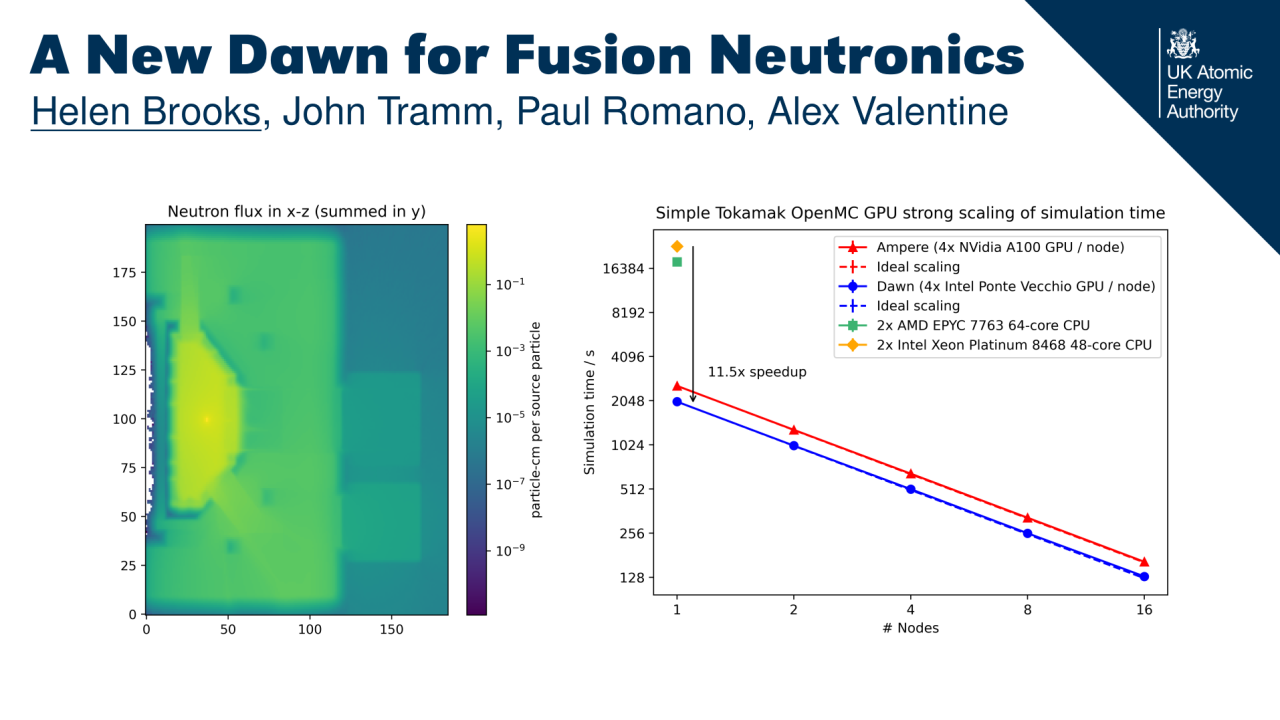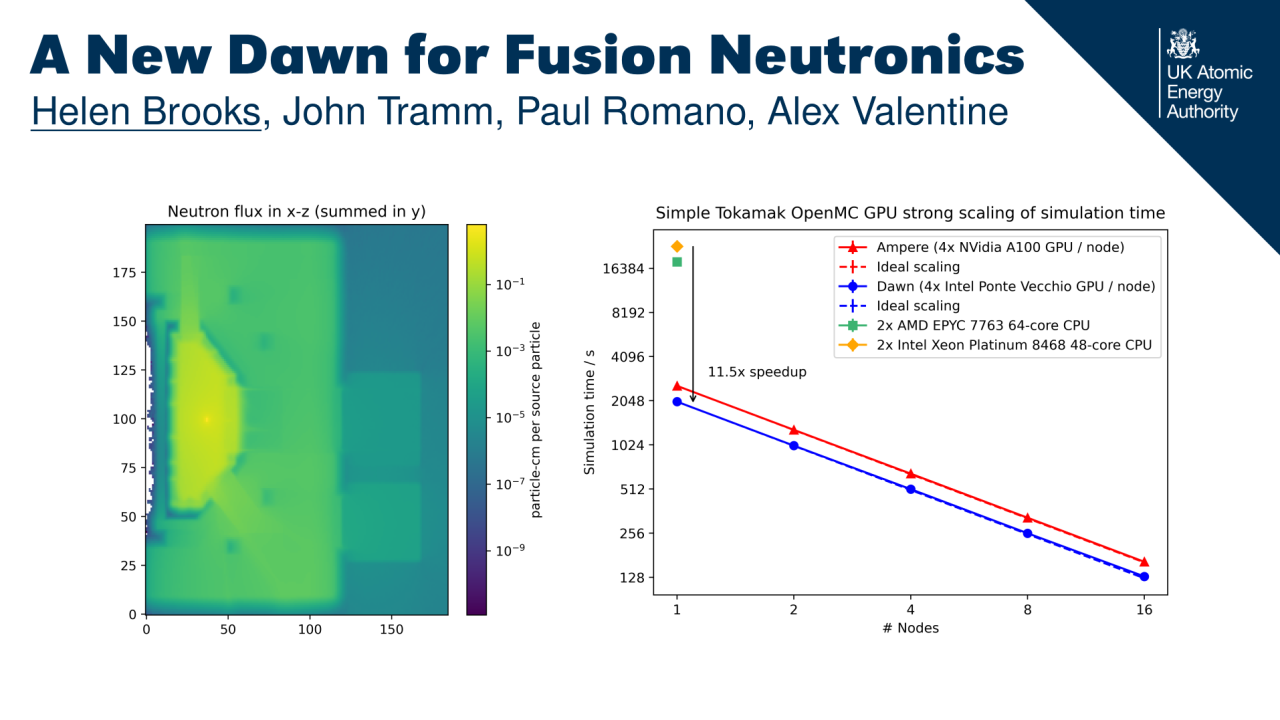

A New Dawn for Fusion Neutronics
Monday, May 13, 2024 3:00 PM to Wednesday, May 15, 2024 4:00 PM · 2 days 1 hr. (Europe/Berlin)
Foyer D-G - 2nd floor
Women in HPC
Computational PhysicsDevelopment of HPC SkillsEducation and TrainingEmerging Computing TechnologiesIndustrial Use Cases of HPC, ML and QC
Information
Poster is on display and will be presented at the poster pitch session.
In 2023 a collaboration consisting of the United Kingdom Atomic Energy Authority (UKAEA), Dell Technologies, Intel and the University of Cambridge, announced the deployment of the Dawn supercomputer at the Cambridge Zettascale Laboratory. Dawn will exploit the same disruptive hardware as the Aurora supercomputer at Argonne National Laboratory (ANL) - namely the Intel Data Center GPU Max - and so represents a decisive step towards an exascale system in the UK. The global proliferation of GPUs is often credited as being driven by advancements in artificial intelligence, and indeed Dawn is anticipated to stimulate research activity in this domain. However such developments do not automatically translate to high levels of productivity in traditional areas of scientific computing like numerical modelling. In the context of the delivery of future fusion power plants, where data are scarce and prototypic experiments prohibitively expensive, development of predictive multi-physics models remains an essential task. It is incumbent upon scientists who develop such models to adopt modern programming practices in order to effectively leverage the available resources in a rapidly changing computational environment. One field having particular importance for fusion engineering simulation is neutronics. Impacting on quantities like radiation dose rates, operational temperature and fuel sustainability, the accuracy of these calculations is of consequence for the safety and economic viability of the future plants. In the field of neutronics, Monte Carlo methods are usually accepted as providing the “gold standard”, but in the highly intricate complex geometry typical of fusion power plant components, significant computational resource is required to attain acceptable convergence in hard-to-reach regions. Fortunately, the particle histories accrued in Monte Carlo neutron transport are independent and exhibit embarrassingly parallel behaviour, presenting an ideal candidate for GPU acceleration. As part of the Exascale Computing Project in the USA, the neutron transport code OpenMC was ported to GPU by employing OpenMP target offload. This work, which focused on fission applications, saw impressive speed-ups and scalability across Intel, NVidia and AMD devices. Following this success, a collaboration between UKAEA and ANL formed to test and extend the GPU capability of OpenMC to fusion applications. In this contribution, we present first-of-a-kind speed-up and scalability results for transport upon a simple tokamak geometry accelerated with the Intel GPUs, that were obtained during early access to the Dawn supercomputer. Furthermore, we observe that such developments were permissible only through the confluence of the following factors: (1) the open source licensing of the software that enabled early user adoption and model sharing; (2) the similarity in architectures of Dawn and Aurora that permitted reproducibility and direct knowledge transfer. By seeking symbioses between the fission and fusion communities, the impact of the original research was amplified. As a consequence, we advocate for continued emphasis on training and skill development and sharing of resources through open source software. Only with sufficient support will scientific progress keep pace with, and maximally exploit the latest developments in the hardware.
Contributors:
In 2023 a collaboration consisting of the United Kingdom Atomic Energy Authority (UKAEA), Dell Technologies, Intel and the University of Cambridge, announced the deployment of the Dawn supercomputer at the Cambridge Zettascale Laboratory. Dawn will exploit the same disruptive hardware as the Aurora supercomputer at Argonne National Laboratory (ANL) - namely the Intel Data Center GPU Max - and so represents a decisive step towards an exascale system in the UK. The global proliferation of GPUs is often credited as being driven by advancements in artificial intelligence, and indeed Dawn is anticipated to stimulate research activity in this domain. However such developments do not automatically translate to high levels of productivity in traditional areas of scientific computing like numerical modelling. In the context of the delivery of future fusion power plants, where data are scarce and prototypic experiments prohibitively expensive, development of predictive multi-physics models remains an essential task. It is incumbent upon scientists who develop such models to adopt modern programming practices in order to effectively leverage the available resources in a rapidly changing computational environment. One field having particular importance for fusion engineering simulation is neutronics. Impacting on quantities like radiation dose rates, operational temperature and fuel sustainability, the accuracy of these calculations is of consequence for the safety and economic viability of the future plants. In the field of neutronics, Monte Carlo methods are usually accepted as providing the “gold standard”, but in the highly intricate complex geometry typical of fusion power plant components, significant computational resource is required to attain acceptable convergence in hard-to-reach regions. Fortunately, the particle histories accrued in Monte Carlo neutron transport are independent and exhibit embarrassingly parallel behaviour, presenting an ideal candidate for GPU acceleration. As part of the Exascale Computing Project in the USA, the neutron transport code OpenMC was ported to GPU by employing OpenMP target offload. This work, which focused on fission applications, saw impressive speed-ups and scalability across Intel, NVidia and AMD devices. Following this success, a collaboration between UKAEA and ANL formed to test and extend the GPU capability of OpenMC to fusion applications. In this contribution, we present first-of-a-kind speed-up and scalability results for transport upon a simple tokamak geometry accelerated with the Intel GPUs, that were obtained during early access to the Dawn supercomputer. Furthermore, we observe that such developments were permissible only through the confluence of the following factors: (1) the open source licensing of the software that enabled early user adoption and model sharing; (2) the similarity in architectures of Dawn and Aurora that permitted reproducibility and direct knowledge transfer. By seeking symbioses between the fission and fusion communities, the impact of the original research was amplified. As a consequence, we advocate for continued emphasis on training and skill development and sharing of resources through open source software. Only with sufficient support will scientific progress keep pace with, and maximally exploit the latest developments in the hardware.
Contributors:
Format
On-site
